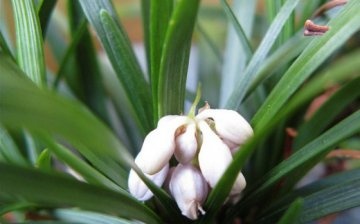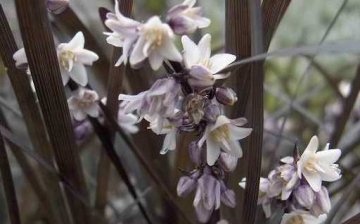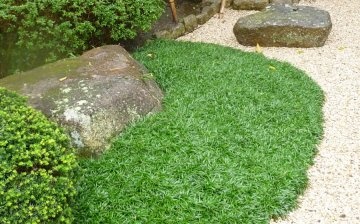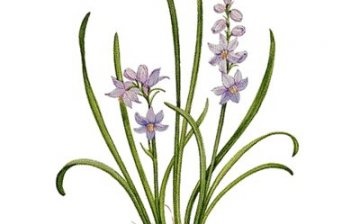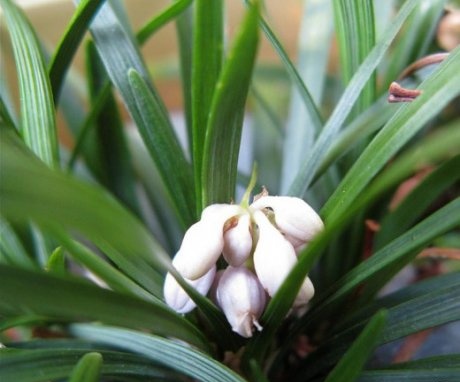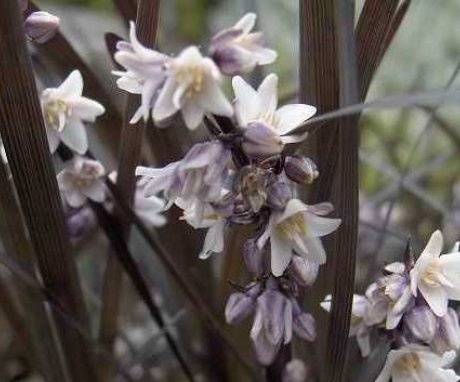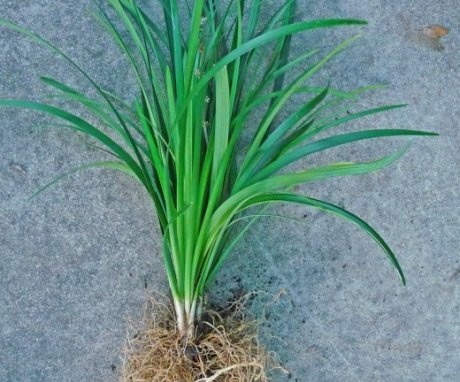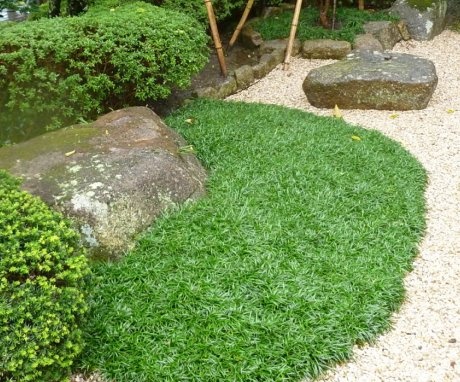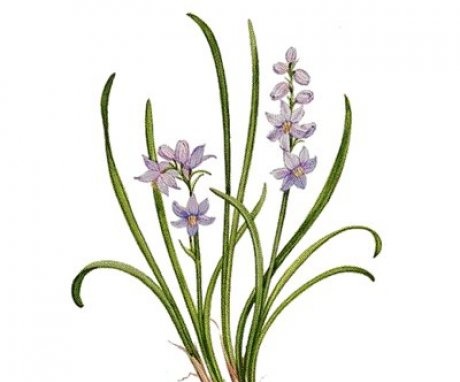Ophiopogon or Japanese lily of the valley
Ophiopogon has a second name, softer and less mysterious - Japanese lily of the valley. The homeland of this plant is Japan, as can be seen from the second name, and China. Belongs to the lily family.
Content:
- Description of the plant
- Ophiopogon species
- Care and reproduction of ophiopogon
- Decorative applications
- Medicinal properties of the plant
Description of the plant
Ophiopogon plant herbaceous and perennial, you can find it in the territories located between the Himalayas and Japan.
This is a very beautiful plant:
- The leaves of which are tough, thin, can be up to 35 cm long.
- The color of the leaves is mostly dark green, but there are also specimens with variegated leaves, and several hybrids with multi-colored leaves have also been bred, especially for their use in landscape design.
Ophiopogon is suitable for growing at home, indoor and outdoors... This is a relatively unpretentious plant, caring for which will not be difficult and does not require special skills. It is very often used as a curb plant. It blooms from July to September.
At this time, he grows a peduncle, the height of which is no more than 20 cm.
A rosette forms on it, with small flowers, the color of which can be either white or pale purple. After flowering, the fruits ripen, small bluish berries.
Ophiopogon species
There are not so many varieties of ophiopogon in nature, there are 20 species in total.
According to some sources, they are much more common in nature, but only 3 species are used for indoor cultivation. The same species can be used for growing in the open field, the main thing is to observe the correct temperature regime.
Ophiopogon Yaburan.
- It is a perennial plant popularly called the white Japanese lily of the valley.
- Its leaves are ribbon-like, and at the tips they seem to be cut off.
- This variety has a fairly high peduncle, with proper care and timely watering, it can stretch up to 90 cm.
- It blooms in white or lilac.
- When growing this species outdoors, it should be insulated for the winter, as it is very sensitive to frost.
- However, there are several hybrids of this species, bred specifically for countries with cold winters. They do not grow so quickly and rarely bloom, but they completely make up for such a deficiency with a beautiful color of the leaves. They can be light green with yellow stripes around the edges, or completely yellow leaves. They can easily endure winter, withstanding frosts down to -15 degrees.
Ophiopogon is Japanese.
- A plant with thin leaves, narrow and tough. Its roots are tuberous.
- When flowering, it releases a short peduncle with a small number of flowers on it.
- It blooms with a lilac-reddish color.
This species also bred several hybrids with modified leaves.
Ophiopogon is flat-shot.
- The leaves of this species are belt-like, and it grows bushy and spreading.
- The leaves are dark green in color. He blooms, like all his brothers, in the summer.
- Its inflorescences are short and racemose, and the flowers are mainly white and purple.
- Several hybrids have been bred, the leaves of which are painted almost black, and the flowers open in a soft cream color.
Such a plant looks very impressive in any flower bed.
Care and reproduction of ophiopogon
For planting ophiopogon in the open field, it is necessary to select a site with good lighting, but not in an open area, but somewhere in partial shade. But if you chose a variety with variegated, bright leaves, then the place should be very sunny and open.
When growing this plant indoors, you need to correctly:
- Pick up soil and pot. To make the right soil for the ophiopogon, it is necessary to mix in equal proportions sand, foliage, humus and turf soil.
- The pots should be low and wide so that there is room for the plant to grow. West and east windows are very good for growth and proper lighting.
- In summer, the temperature of the room where the ophiopogon is located should be no more than +25 degrees and not lower than +18.
- In winter, the plant feels great at a temperature of + 5- + 10 degrees.
- If the heating is turned on in the room where the plant is located in winter, then it is necessary to spray it periodically in order to avoid overdrying the leaves.
On the open ground for the winter, it is advisable to insulate the plant, although there are species with good frost tolerance.
When watering, it is necessary to control the moisture content of the soil, it should not be overdried, but in a swampy environment the plant may disappear. In a humid environment, the roots begin to rot. In summer, the plant is watered often and abundantly, the main thing is to avoid stagnant water. In winter, watering is practically not required, but the soil should not be dry either.
Every year ofiopogon fertilizer needed... The best choice would be mineral and organic fertilizers. They are applied to the soil 1 or 2 times a week in the spring and summer.
There is practically no need to care for this plant:
- After planting, it is sometimes worth plowing up the soil and removing weeds.
- After a time when the plant grows enough, then the need for this procedure will disappear.
- Another advantage is that the plant does not need pruning at all, but forms on its own.
Ophiopogon gives a very large number of shoots, so the main reproduction is by dividing the bush. There is another option - these are seeds, but such reproduction is not effective and long-term. The division of the bush occurs when the plant is transplanted. It can be carried out once every 2-3 years in the spring for a plant growing in the open field. If ophiopogon grows indoors, then transplant into a wider pot, or reproduction is carried out annually, also in spring.
When dividing the rhizomes into processes, the number of leaves left should be taken into account, there should be about 8-10 of them. Transplanted into prepared soil in a pot with drainage at the bottom.
This plant, like many street plants, is quite resistant to diseases and pests.
But under various circumstances, ophiopogon can weaken and suffer from certain insects. In humid places, such as greenhouses and greenhouses, the whitefly can attack the ophiopogon. It is a small moth that lays eggs on the leaves of a plant. If the plant is already heavily infected, then it is necessary to remove insects with the help of various preparations, which are widely represented on the shelves of specialized stores. But if the plant has just been attacked and the number of insects is extremely small, then you can transfer it to a cooler and drier room. Whiteflies do not tolerate temperature extremes.
There is another insect pest that is very fond of ophiopogon. These are thrips.
Such insects can be removed only with the help of chemicals. The main thing is that the processing must be done several times in order to kill an adult, and after a while the born offspring.
Decorative use
Ophiopogon is very often used in landscape gardening:
- Designers use it as a border for flower bedsthat looks very beautiful and original.
- Ophiopogon is also widely used as a ground cover plant due to the fact that it grows quickly and completely covers the soil with its colorful leaves. The great advantage of this plant is that it does not have a leaf-shedding period.
Many landscape plants have an annual wilting period followed by foliage shedding, leaving a lot of debris on the beds. Ophiopogon retains the color and shine of the leaves all year round, and the death of old leaves is almost imperceptible.
When planting ophiopogon on the soil in a flower bed or flower garden, it must be borne in mind that the plant grows rapidly, and if there are short plants nearby, they can disappear under the onslaught of the Japanese lily of the valley.
It is very good to combine ophiopogon with decorative undersized trees... Growing and covering the soil, it will retain moisture for the tree longer, which will have a beneficial effect on it.
Medicinal properties of the plant
Japanese lily of the valley is very popular in China and is often used in traditional Chinese medicine.
To obtain the required raw materials:
- Dig up the ophiopogon root, carefully discard and dry in the sun.
- When the root loses 80% of its moisture, the adventitious roots are cut off and drying continues.
In China, as well as in Japan, the chemical composition of the root is studied in laboratories. It contains saponins, polysaccharides, fatty acids, cyclic peptides. Laboratories are studying the effects of some constituents of the ophiopogon root on liver cancer and other cancers. The isoflavonoids also contained in the root have anti-inflammatory effects.
In traditional Chinese medicine, it is recommended to consume the ophiopogon root when the cold weather sets in.
During this period, there may be a lack of Yin energy. It is also used when the functions of the gastrointestinal tract are impaired. The scope of application of such medicinal raw materials has not yet been fully studied, and work in this direction is actively continuing. It is possible that after a while new preparations containing ophiopogon root will appear in pharmacies.
More information about lilies of the valley can be found in the video.




